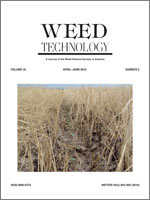Sprayer applicator–controlled variables, such as nozzle selection and ground speed, will become increasingly important for making labeled POST applications of dicamba in next-generation cropping systems. Typically, nozzle orifice sizes and ground speeds differ greatly between small-plot research applications, from which efficacy recommendations are made, and commercial field applications. However, little research has been conducted to compare applications made with backpack sprayers and tractor sprayers. Thus, a field experiment was conducted in 2013 and 2014 at the Northeast Research and Extension Center in Keiser, AR. Tank mixtures of EngeniaTM (N, N-Bis-(aminopropyl) methylamine form of dicamba), Liberty (glufosinate-ammonium), and Liberty Engenia were applied with TeeJet XR, TT, AIXR, AI, and TTI nozzles at 5 km h−1 and 20 km h−1. Two nozzle sizes (110015 and 11006 rated at 0.58 L min−1 and 2.27 L min−1 at 276 kPa, respectively) were used to keep spray volume constant at 141 L ha−1, whereas ground speed was varied. Weed control ratings were typically lower at 5 km h−1 than at 20 km h−1. For example, Palmer amaranth control 4 WAT in 2013 with glufosinate and the TTI nozzle was 89% at 5 km h−1 and 96% at 20 km h−1. More differences between speeds were observed for the coarser nozzles, such as the TTI and AI, as opposed to finer nozzles, such as the XR and TT. Results from this research suggest increasing orifice size increases droplet size and that other factors related to applications at faster speeds (e.g., higher droplet velocity, disruption of the crop canopy) may influence the efficacy of herbicide applications. However, increasing ground speed is not a recommended means for increasing efficacy of herbicide applications.
Nomenclature: Dicamba; glufosinate; glyphosate; barnyardgrass, Echinochloa crus-galli (L.) Beauv.; Palmer amaranth, Amaranthus palmeri S. Wats.
Las variables controladas por el aplicador, tales como la selección de la boquilla y la velocidad de aplicación, serán cada vez más importantes para realizar aplicaciones POST de dicamba según la etiqueta, en los sistemas de cultivos de siguiente generación. Típicamente, el tamaño del orificio de la boquilla y las velocidades de aplicación difieren ampliamente entre aplicaciones en pequeñas parcelas de investigación, a partir de las cuales se hacen recomendaciones de eficacia, y las aplicaciones en campos comerciales. Sin embargo, se ha realizado poca investigación para comparar aplicaciones hechas con bombas de espalda y aspersores de tractor. De esta forma, se realizó un experimento de campo en 2013 y 2014 en el Centro de Investigación y Extensión del Noreste, en Keiser, Arkansas. Se aplicaron mezclas en tanque de EngeniaTM (la forma N, N-Bis-(aminopropyl) methylamine de dicamba), Liberty (glufosinate-ammonium) y Liberty Engenia con boquillas TeeJet XR, TT, AIXR, AI, y TTI a 5 km h−1 y 20 km h−1. Dos tamaños de boquilla (110015 y 11006 graduadas a 0.58 L min−1 y 2.27 L min−1 a 276 kPa, respectivamente) fueron usadas para mantener constante el volumen de aspersión a 141 L ha−1, cuando se varió la velocidad. Los valores de las evaluaciones de control de malezas fueron típicamente menores a 5 km ha−1 que ha 20 km h−1. Por ejemplo, el control de Amaranthus palmeri, 4 semanas después del tratamiento (WAT) en 2013, con glufosinate y la boquilla TTI fue 89% a 5 km h−1 y 96% a 20 km h−1. Más diferencias entre velocidades fueron observadas con boquillas de gota de mayor tamaño, tales como TTI y AI, en contraste con las boquillas de gotas más finas, tales como XR y TT. Los result






